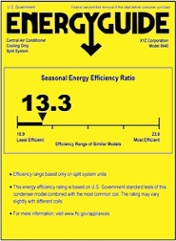Know Your Terms – Heat Pump Efficiency Ratings SEER & HSPF

 If you’re in the market for a new heating & cooling system and you’re looking at heat pumps, make sure you understand how they’re rated for efficiency – and which rating is more important for you.
If you’re in the market for a new heating & cooling system and you’re looking at heat pumps, make sure you understand how they’re rated for efficiency – and which rating is more important for you.
If you’re in the market for a new heating & cooling system and you’re looking at heat pumps, make sure you understand how they’re rated for efficiency – and which rating is more important for you.
Most people – and this includes those in the HVAC business – when asked what the efficiency of a given heat pump is, will tell you the SEER rating. That’s only part of the answer, though.
Heat pumps, you see, work both ways. It’s basically an air conditioner with a reversing valve that lets it run backwards in winter. They cool in summer and heat in winter, and each function has its own rating.
- SEER stands for Seasonal Energy Efficiency Ratio and applies only to cooling. (It’s not a great measure of efficiency, but that’s the topic of another article.)
- HSPF stands for Heating Season Performance Factor and is basically the SEER rating for winter.
Heat pumps don’t work so well when it’s really cold outside because they pump heat from the outside air into the house. (Ground source heat pumps, sometimes misleadingly called geothermal heat pumps, don’t have this limitation because the ground doesn’t get so cold, but I’m just talking about air source heat pumps here.) The colder the outside air is, the less heat they can pump inside. For this reason, you don’t see many heat pumps in cold climates.
You don’t have to go to cold climates, however, before heating becomes more important than cooling. Here in Atlanta, for example, homes often have annual heating loads that are two or three times more than the cooling loads. If that’s the case for you, too, then you need to look more at the HSPF than the SEER when you’re shopping for an efficient new heat pump.
Currently, the minimum SEER and HSPF that you can buy are:
- SEER 13
- HSPF 7.7
If you buy an air source heat pump with a higher SEER rating, it will usually have a higher HSPF rating, too, but make sure you focus on the latter number if your heating load is higher than your cooling load. If you’re in the market for a new heat pump, here’s a guide to help you choose:
- Consider improving your building envelope with air sealing and insulation to minimize the amount of heating & cooling your home needs.
- Look at your energy bills for the past 12 months (or 24 or 36 if you can get them). Determine whether you’re spending more on heating or cooling.
- Even better, get a home energy rating, which will show you the annual heating and cooling loads for your home.
- To size the system properly, get a Manual J heating & cooling load calculation to determine the peak (rather than annual) loads.
- If heating dominates, consider getting a heat pump with an HSPF of 8 or higher, rather than the minimum of 7.7.
- Also, make sure you get a thermostat with adaptive recovery to minimize your use of supplemental heat in the winter.
